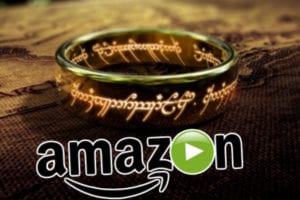Every trip to Middle Earth that Peter Jackson and Co. take us on begins with something of a prologue. Some are longer than others, some are more effective and entertaining. But each one of these prologues does its due diligence to set the scene of the film you are about to see, to introduce a plot point that might be revealed, or to expose new information on an important character.
The final installment of The Hobbit Trilogy, clumsily entitled The Battle of the Five Armies, does not have this scene. Welcome back folks… to the most thrilling climactic chapter of any story ever to be brazenly adapted and stretched out into three films. This installment is sure to go down in the history books. Let’s just dive right in, because there’s so much to analyze; so many plot holes to roll our eyes at. P.S. if any of you got my reference to the novel in the title of this article, you get a share of Thrór’s treasure hoard.
Fire and Death
We jump right into the action with Smaug on his way to destroying Laketown. Remember all the hype and marketing that had been done to prepare us for the awesomeness which we are about to witness? Well get ready to be stunned for like 12 minutes. We’re just sort of thrown into an action sequence and it’s rather jarring. This tool can and has worked in fantasy time and time again…okay well, it’s mostly in video games or Greek mythology, but you get my point. But this opening sequence leaves so much to be desired. They zero us in on a cast of characters that Jackson & Co. mistakenly assume we already care about. We don’t. This failure to reestablish our cast of characters and their relationships with one another sets the tone for the entire “story” that is about to unfold.
They had a chance to reinvigorate the paper-thin characters they had thrown at us in DoS, but that’s not their prerogative. The filmmaker’s concerns are more directed at how spectacular and marketable a set piece this segment will be. While the visuals are stunning, and Cumberbatch’s vocal performance is testament to his unwavering talent, the segment fails to hide the fact that it clearly belongs at the end of DoS. There’s nothing for any of the characters to do in Laketown other than watch–even the characters directly in the fray are sidelined as spectators. They’re not trying to help people escape, they’re not bickering among themselves or trying to prevent the master from making away with the town’s wealth—nope, we’re all just helplessly watching a Bard uses his son as a makeshift crossbow? Is this significant? Was this event foreshadowed in any other way besides “only a black arrow can kill the dragon…oh, here’s one!” No, nothing in this action sequence tells any kind of story or lays any kind of foreshadowing for the upcoming events.
It’s a twelve minute plot point. The dragon is dead because Bard is a good shot.
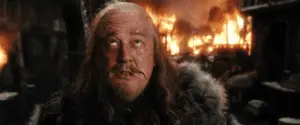
*Plot hole award of this segment: Bard having a random 50ft rope in his jail cell that he places perfectly down to catch onto the master, whose temporarily crucified body applies enough pressure to break Bard out of the flimsiest jail cell of all time.
Keeping A Sinking Story Afloat
Okay so we don’t get any sort of character growth or relationship building from any of this, but Smaug dies and the Master dies and Laketown is destroyed. So now there’s a plot. There’s also another stale scene with Tauriel and Kili where something interesting almost happens between them, but then Legolas shows up (I guess he gave up pursuing Bolg because the plot needed him) to prevent that. So Kili gives Tauriel his mom’s rock and then floats away with his friends; who have no lines that address anything that has happened or how they might feel about it. We don’t have time for character building, or interesting diologue , the dwarves have places to be.
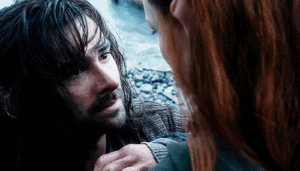
So the people of Laketown have had their homes destroyed and they’ve lost loved ones and need to recoup their losses and migrate. But what’s more interesting to me would be to see Alfrid–a character who has no business in these films at all– fight over a blanket and worm his way into a high station in society again. I’m also desperate to see if Bard will reunite with his wooden family. Well, this all happens, thank goodness. Then things get really crazy when they make a plan to go elsewhere. There’s this fantastically bad melodramatic pause before the last line of the scene that leaves me wondering if the filmmakers are just having fun with self parody.
Hilda: What do we do then?
Bard: (after a hair flip and a long pause) We find shelter.
Wait, Who’s Hilda? Oh, she’s just this stock character who is always there to tell us that Alfrid is a snake or a weasel or a jerk. I don’t know what her relationship to any of the characters is, or what her connection to the story is, but thank goodness she’s here to give Alfrid a hard time because if it weren’t for her, I’d have thought Alfrid was the hero of the story…I mean he gets considerably more screen time than Bilbo.
*Plot hole award of this segment *They go as far as ripping word for word a line from the Simpsons and it’s completely out of context of the scene. It’s not really a plot hole, but it’s infuriatingly bad writing that reaches a whole new level of insulting.
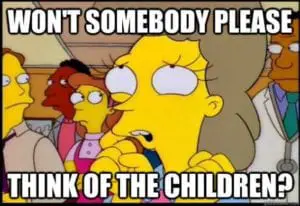
Dragon Sickness
Speaking of Bilbo, how does all this vacuous, uninteresting plot development reflect on our hero? Well he’s already been robbed of having it be him who discovers the weak spot on Smaug, and communicating it to the thrushes so they can tell Bard. So what’s left? Does Bilbo feel some form of looming guilt for having released a dragon onto innocent people? And the rest of the dwarves must be grieving for the assumed loss of their companions, whom most have blood relations with, right? Well that’s all very unimportant. The focus is on Thorin, who has been taken by dragon sickness. Bilbo is concerned for his friend, and in doing so completely steps over the fact that some characters he’s supposed to care about are not, in fact, dead.
You see they could have done all this by devoting some screen time to Bofur, Fili, Kili, and Oin on their journey up the mountain. Perhaps they address the traumatic event that just transpired and will have some insight to share with the rest of their company. Perhaps they will address the relationship building between their companion and an elf whom they are not sure to be trustworthy. It’s good to have the plot now heavily focus on Thorin’s dragon sickness, but because Jackson and Co. fail to differentiate between the dwarves and their relationships to one another, everything that happens in Thror’s treasure horde boils down to Thorin bossing around a bunch of bearded extras.
They even film a bunch of seemingly foreshadow-y close ups of Fili reacting to Thorin’s treasure obsession. So maybe Thorin’s heir will also be affected by the treasure, and there will be a big falling out, or some dramatic tension that the dwarves will need to band together to overcome. They don’t specify say that Dragon sickness is only subject to one dwarf per company, and the way they are shooting this scene makes it feel like Fili will have some significant part to play with this treasure horde.
He doesn’t. None of them do. The treasure horde is just a tool used to get in the way of Bilbo and Thorin’s relationship.
Wouldn’t it be interesting to hear them all talk about how Thorin is evil for having dragon sickness, while at the same time showing that at least half of them have some form of it, and it’s tearing the company apart? At least you’d have an excuse for your reunion scene to be so weightless: they arrive at Erebor and find that everyone is consumed by the treasure so nobody cares about the return of Fili and Kili and Bofur and Oin. All they care about is the gold.
Seriously, there’s a bunch of cut scenes where the dwarves are searching through the gold and it’s like: do none of them have anything to say about suddenly just becoming the richest beings in all of Middle Earth? They’re all immune to the fact that they can all go full Scrooge McDuck with their money and that creatures from every corner of the world will surely come to take their treasure? Just saying. I like what Jackson & Co did with the Arkenstone business, at least it was mildly interesting and involved Bilbo, but maybe if they involved our company of dwarves in their film, BoFA might have some characters that are actually worth investing in..
*Plot hole award of this segment* Balin seems affected by his long time friend being consumed by greed, but the scene is only there for exposition, and Balin never is aloud a moment of resolution with Thorin.
Brooding Kings and Supporting Casts
Boy does this film want you to know that the gold is turning Thorin into a monster. Bard tries to reason with him and begs to get his people their fair share of the treasure, but Thorin says no. Then elves show up on Thorin’s doorstep and still he won’t budge. He’s yelling at all his friends and acting all suspicious and just generally becoming an unlikable character. It’s potentially interesting, but it never really amounts to much. Thorin is being painted as a tragic deuteragonist, but his tragic flaw (greed) never ends up being his undoing. The film is way more concerned with organizing a contrived final showdown between Thorin and the most uninteresting villain ever.
Thorin isn’t the only brooding king here either. Thranduil does his fair share as well. They are just two Kings who like to brood and throw tantrums and boss people around. I don’t mind Thranduil’s moodiness, as that’s already been somewhat established, and I think Lee Pace does a fine job of portraying an elegant asshole while still managing to be likable. His performance actually exudes what I had imagined many of the elven princes to be like when I read the Silmarillion. it’s just a shame Lee Pace has no supporting cast to play off of. It’s just sort of him commanding a bunch of computer imagines and that’s not at all interesting.
Thorin’s brooding quickly goes from sympathetic to boring as they beat you over the head with it, and if it weren’t for Bilbo’s plan to give away the Arkenstone, everyone else would just continue to sit around and get yelled at, since none of the other dwarves were given any lines. Thorin turns away Bard, he stays stubborn and unwavering when the elven army approaches, and the relationship between he and Bilbo comes to a head when he finds that the Hobbit betrayed him by gifting the Arkenstone to the enemy.
It’s so hard to watch this scene without feeling sorry for other dwarves in the scene who are literally just standing around and reacting to the argument. I know I’m going on about it, but really, they’re so under utilized and it’s such a bummer. Scene after scene, the bulk of them watch on helplessly, but never is this more prevalent than when Thorin tries to throw Bilbo from the ramparts and our “main cast” just looks on helplessly.
So Thorin’s a jerk now, and that’s fine, at least something is happening to one of these characters. But how does this get resolved? There’s a single scene with Dwalin, whom Thorin has had almost no direct connection with in the entire film, and this seems to be enough to turn it all around. It causes Thorin to have this odd trip where he watches himself get swallowed up by a poorly rendered CGI pool of gold. So why wasn’t this scene given to Balin, who shows the most concern for Thorin within the framework of this film, and who has the longest, most meaningful relationship with the character? “Get out before I kill you,” would have carried so much more weight when said to a character whom we’ve actually seen shed tears for his king like 10 minutes earlier. And what of the Arkenstone? Is Thorin just going to forget about that?
Oh well, all is forgiven and Thorin then returns to his kin for an underwhelming battle charge.
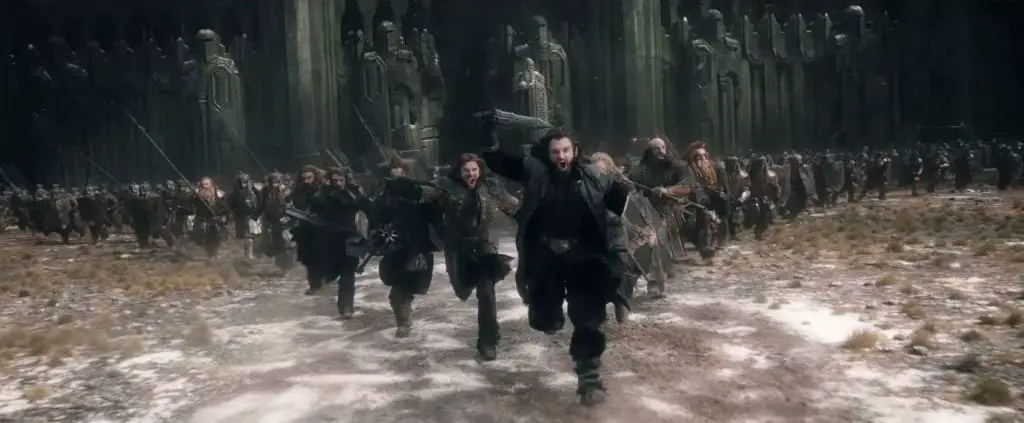
Prepping for Battle
The battle prep suffers from the same annoying warp-holes that plague other high fantasy entertainment as well.
“Tauriel and Legolas ride from Erebor to Angmar where the orcs’ army is rallying in what seems like a few hours, though that journey would have been about 300 miles each way—plus required crossing a mountain range—in Tolkien’s world. Likewise, Dáin Ironfoot, Thorin’s super-Scottish cousin, gets summoned by a raven and manages to rouse an army and make the 150-mile journey from the Iron Hills in what seems like a day-and-a-half.”
So Legolas takes Tauriel on a quest that essentially amounts to them discovering that Bolg is moving with an army. We find out that Legolas’ mother dies in Angmar, and that’s apparently significant to his character. But his and Tauriel’s relationship stays completely stagnant in that moment, rendering this scene….no this entire plot line…no these entire characters superfluous to the film. I mean there isn’t even a cliche moment where the two characters bond over their respective life tragedies and grow closer over it. Tauriel just doesn’t care about Legolas and it’s so boring to watch. But who could blame her, honestly? He’s as boring and lifeless as her.
At this point I’m begging for a cliche scene that attempts to follow some antiquated story structure where girl feels bad for boy so girl gets romantic with boy out of confusion and pity. Anything. Please. Instead, it’s just Legolas going “hey, my mom’s dead.” Then they turn right around and go back to warn the others of this second orc army. It really is riveting, my description doesn’t do it justice, you must see for yourself.
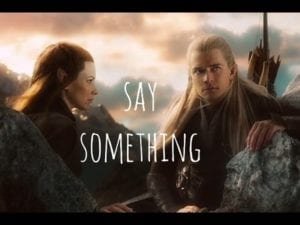
Also in preparation of the battle is the return of Gandalf, who is rescued from Dol Guldur by the white council and Radagast. Part of the problem I had with the Dol Guldur segment in DoS was not just it wasted our time setting up a villain whom we had already seen defeated, but that it was so much time wasted. And it makes it so much worse when the Dol Guldur plot of BoFA is simply wrapped up with one (really bizarre) action sequence featuring characters that will disappear as quickly as they’ve entered the film. The juice is not worth the squeeze in Dol Guldur, and it’s disappointing to see not only the interesting characters be wasted on such a shallow spectacle that plays more like a boss fight in a video game than anything else, but it’s a waste of talented actors as well. It’s endemic in this film to stick our heroes in some contrived danger, build false suspense as an enemy takes way to long to strike a killing blow, and then the hero is rescued at the last second. It’s not a subversion, it’s just a lazy crutch. Well, at least the verdict is officially in on this front: The Dol Guldur plot line can officially be categorized as “ nostalgic padding”.
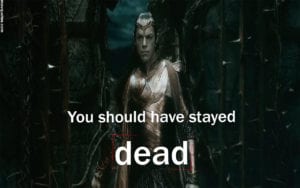
Battle of the Five Armies
Remember when the only things people were worried about concerning this film was whether or not the title would work and which armies constituted the five armies? Well for the record, I think the title is ridiculous and gauche and pretty much a direct insult to Tolkien’s text, who wrote the entire battle segment in 5 pages to illustrate how fruitless, ridiculous and frustrating war is. But, as evidence of this article there is so many more things to concern ourselves with when it comes to this joke of a movie.
So Dain Ironfoot, Middle Earth’s own outrageous Scottish stereotype, flies onto the scene on the very same morning as the elves. It’s not really offensive in any way, seeing as it’s just Billy Connolly being Billy Connolly, but what is offensive is the amount of blinding CGI the entire segment is painted with. Connolly had reportedly been struggling with health problems, so it’s understandable that they needed to enhance his role, but you know they couldn’t wait to add Dain’s character to the list of things that they could just design digitally.
The dwarves are about to charge the men and the elves, when what do you know, the orcs pop in uninvited at the very same time.But they couldn’t have just marched on in, no. The orcs had to enlist the help of some giant were-worms that dig tunnels for their passages, and then are never heard from again. Just another means to an end in this fine, fine script.
When the orcs enter the fray it’s rather disorienting. The dwarves make this really badass looking phalanx and seem to have this incredible defensive stand, but then it’s completely cancelled out with what is supposed to be a triumphant moment of unity between dwarves and elves. But like…just from a tactical standpoint, it’s poor planning. Why would you leap over the giant wall of shields that are in perfect position to absorb the attack? Why not show the clashing of orcs and dwarves? Any nerd worth their salt (myself included) was completely salivating the first time they saw a fully formed dwarven army at last take up arms on the big screen. Show it. Then you can build suspense as to whether or not Thranduil and his elves will help. This “last second subversion” crap is a plague. I feel cheated.
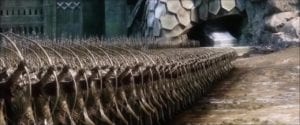
The battle then consumes the remainder of the film. The dwarves and elves fight the orcs in open field, then the men of Laketown realize that more orcs are headed for dale, so they sloppily rush home to defend it, and now we’re fighting on two fronts. But Thorin and Company are still held up in Erebor, so we’ve got to wait around a bit. Don’t worry though, there’s plenty of scenes where Alfrid acts like a huge ass, and doesn’t get his comeuppance or learn anything, while Bard rescues his kids from danger with the same tired deus ex machina trope that hasn’t worked the entire film.
The battle amounts to a forty minute set-piece that has less intriguing strategy than it does emotion. At times it feels like there were just a bunch of random hack-and-slash scenes splices together in order to create the illusion of a battle. The only enemy we’ve had any interests in for the entire series is Azog, and he’s up on this giant tower thing playing with flags. So nothing in this battle has any stakes for anyone, because there is no villain. There is no pendulum swinging, and anytime a character is presented with peril, they either find a solution immediately, or the problem is deus ex machina’d away by a hero that was off screen but is now on screen saving the day. It’s bland and it’s tension-less because it has no story to tell while its main characters are hiding away in their hold.
As the dwarves hide away, we are told who is winning and losing through Gandalf who shatters the “show don’t tell rubric” time and again during this battle. At times, it seems as though the music is the only thing that is telling us what is happening during the fight. Azog and Gandalf act as narrators, and the music is telling us to feel emotional because the battle is going ill apparently, but then they’ll cut to Thranduil and he’s just tearing through orcs like paper. The editing is simply atrocious.
Then the men scurry off to Dale because time is meaningless. Then, as orcs with fully equipped siege weapons take on a gaggle of peasants, we are again told through music cues that this battle is going ill. But if you watch Bard’s dumb luck heroics, you would not guess that. It’s just more of the same montages of Bard slaying orcs, and then Alfrid continuing to do shady things. There’s one scene in particular where everyone is told to fall back to the keep. Random peasants run by to tell the audience that they are overrun (I wish I was making this up) and it’s like…why? Bard tells his kids to head the keep, because it’s safe there. Thank goodness those peasants heard his conundrum as they were running by.
The women and children and wounded are held up safely in the keep, but then Hilda, everyone’s favorite random peasant, decides that she’s going to go out and fight the orcs with the men, because what would a terrible fantasy film be without a poor attempt to pander to women’s empowerment? Seriously the scene cuts to her and she stands up yelling “I say, we stand with our men in life, and in death,” as if she was arguing with someone that was advising to, you know…stay safe. But she wasn’t talking to anyone. She just stands up and suggests it, and everyone sort of just goes along with it.
Like most of the lazy happenstance in this film, nothing is earned. And then the women go out and fight…but like, there’s no evidence that them joining the fight did any good at all nor was there a moment that told us their help was even needed. Were the orcs breaking into the keep? Were they surrounding the remaining forces of men? You have to like…show us what’s happening. Is this honestly the same creative team that brought us the battle for Helms Deep? You’d have a tough time convincing me that this creative team had ever seen a fantasy battle on screen let alone created some of the most iconic on-screen battles ever made.
Why Else is This Battle So Empty and Terrible?
I’m glad you asked. There’s a whole mess of issues as to why this battle is just every kind of awful.
It’s too big.
There aren’t enough interesting characters to warrant “splitting up the front” onto two planes. Anyone who isn’t Bilbo, Thorin, Gandalf and like…maybe Bofur…are completely one dimensional and not relatable characters, and now you’re going to split the battle up into like four set pieces with characters that don’t just lack redeeming qualities, but they lack any type of quality or relationship with one another at all. It would almost be funny it if weren’t Tolkien. But it is Tolkien, so it’s just upsetting and rage-inducing. There’s so many things happening in so many places with so little stakes I want to scream.
Nobody wants anything.
The entire battle is just hordes of CGI orcs crashing into hordes of dwarves and elves and Bard. There is no clear objective for our heroes, and very little story happening until Thorin finally arrives, and even then there’s not much to tell. Thorin’s big “plan” is to take a bunch of goats that magically appear (yes, I’ve seen the extended edition) and run up to face Azog. What brilliant cinema.
It’s Overloaded With CGI
The entire valley setting is an over-saturated computerized environment, the elves are coated with glossy armor that is so blinding I can’t even look at the screen sometimes, and the dwarves have almost identical armor to the orcs. There’s one shot in particular that is so off-the-walls-bad where Dain is just headbutting orc after CGI orc and it just completely obliterates the idea that these enemies are dangerous.
Lack of Consequence
Every time the heroes try to do something, they succeed. Want to kill a dragon ? Great! Want to smash a rock-wall with a giant bell? Great! Want to charge up a mountain riding some random goats that just appeared? Great. Want to ride down a narrow causeway on a cart and smash into a troll so’s to rescue your kids? Also great. Whatever you decide to do, your plot armor will protect you, even if that means filming absolutely nothing interesting at all.
Lack of Camaraderie
After Thorin and company make their charge, that’s the last you hear from the “other dwarves.” This band of funny folk you just spent 8 hours with? They are given nothing of value to do in this battle…of course that’s right on par with this film in general, as none of them say anything during the film either. Nobody is helping one another, nobody seems to be in any peril (unless you are Bard’s prop-children), and it just goes on and on with one CGI cutscene after another featuring a bunch of separate heroes separated by a bunch of generic enemies.
Legolas
When Legolas joins the fight, all bets are off. He’s just there for the audience. He has no connection to any character other than Tauriel, and she doesn’t seem to genuinely care about him, so why is he here? To fight Bolg, and defy gravity. The moments are so over-the-top and so cringe-worthy that I cannot even justify analyzing them. Bolg is a stupid enemy and Legolas’ character was completely murdered during the course of this film. They even give the same emotional weight to Legolas fighting Bolg as they do with Thorin fighting Azog. They cut back and fourth between the two fights and it completely undermines any tension they created with Thorin and Azog
Erebor is Abandoned.
After the 13 dwarves make their rally charge, the segment of battle in front of Erebor is completely abandoned, and we are introduced to ANOTHER location in Ravenhill. Enough already, this film is terrible. Keep your heroes together near the home they fought so dearly to obtain. Who knows, maybe they start to get overrun and the dwarves tell everyone–men, elves, dwarves, to fall back into the home which they spent the entire film keeping everyone out. Maybe some conflict arises between characters who do want this, and ones who don’t. Make the reason the dwarves came out to fight be a significant one. Make some bold choices. Not a single orc breaks into the mountain and touches a piece of gold, why not make one of the planes of your fight be in the treasure hall? Didn’t we just spend an entire movie where a character became obsessed with treasure? Wouldn’t it be ironic if his greed caused the death of his kin somehow?
Everything is Anticlimactic and Nothing Has Any Narrative Purpose
There are countless set-ups made in this trilogy that are given no emotional or narrative payoff. All the dwarves are given specific character traits (and you can barely call them that) like Fili always having a weapon in his back pocket, or Gloin not wanting to give bard his money when they needed safe passage to Laketown, or Bofur being the only dwarf Bilbo talks to about not having a home, and none of those things have pay-offs. Fili is captured in a cave and dies in an anticlimactic way, Gloin seems unaffected by the treasure like the rest of them, and Bofur is one of the only dwarves who doesn’t get to enter Erebor with the rest of them. These are just tiny examples though, but as Thorin faces off with Azog, removed and isolated from the entire story, we come to realize that in fact, the majority of every plot point up to this point, has been a means to an end.
Just a few more reasons…
- Kili and Tauriel’s relationship bares no significance to her relationship with any other elf or dwarf or otherwise. Likewise with Tauriel’s and Legolas’ relationship.
- Thorin’s dragon sickness is not a tragic flaw, it’s just a way for the battle to stretch out.
- Beorn
- Alfrid has no arc. He doesn’t redeem himself, he doesn’t suffer any consequences, he’s just in the Tolkien universe now, wandering around in a dress.
- Nothing is resolved concerning the treasure. Thranduil does not receive his family’s gems, the people of Laketown are still homeless as far as we know.
- Not that Bard had any goals or traits to speak of, but it’s not officially shown that he becomes the new Lord of Dale.
- Thorin’s funeral is not shown, and the dwarven kingdom is leaderless.
- Bilbo never plants the acorn he shows Thorin.
Many Partings
After the battle ends, and Thorin is killed in an un-heroic way, and his nephews don’t die defending him, as it clearly states in the book:
“Of the twelve companions of Thorin, ten remained. Fili and Kili had fallen defending him with shield and body, for he was their mother’s brother…”
—The Hobbit, Ch. 18 The Return Journey
It’s fine though. Fili randomly getting trapped in a cave and Kili having a slow motion death from Bolg is like…incredibly poetic. Bilbo has a lovely moment as Thorin quotes directly from the book and I can tell that Martin Freeman and Richard Armitage are very talented, and I know that they feel affected by what’s happening. That’s about all the scene delivers for me though. And then the Eagles show up with a thud and we all just assume the battle is won.
And that dreadful scene between Thranduil and Legolas like…what was that? Who wrote that? Why? If that was just a Marvel-esque way to keep us wanting more, I’m all set thanks. I hope to Illuvatar that if “Stider’s childhood” is where the Amazon series picks up, that it has the courtesy to create more compelling characters than this. Because wow, that was the most cringe-worthy display of self aware pandering I’ve ever seen. It seemed like something out of a video game.
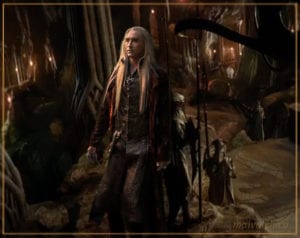
Before you know it, Bilbo is on the borders of the Shire, and this nightmare is checking out before you can even register how terribly constructed the film you just watched was. Bilbo slinks away and is stopped at the last minute by the dwarves as if his one-night stand just woke up and asked him to get some breakfast. And that’s that. Bilbo never has another interaction with Bard, he never meets Dain…it’s all so lackadaisical, I’m almost impressed.
It’s as if Jackson & Co wanted to avoid the criticism that their epic conclusion to their epic fantasy adventure had too many endings, so they just skipped all resolution all together as an over correction. (For the record, Return of the King’s ending is perfect, and the story never stops: the fellowship parts, Aragorn is made King, Sam works up the courage to court Rosie, and all the while Frodo is struggling to shake off the wounds that the ring has left, it’s only after he passes on his uncle’s story to Sam, and parts with his friends with a smile at the Grey Havens, that Frodo’s story comes to an end; it’s perfect.)
So how do we as fans come back from this? How could the world go back to the way it was when so much bad happened?
After The Battle of Five Armies came out, I was so disgusted with what my favorite franchise had turned out to be that I didn’t even know what to do with myself. With any luck, this franchise will be invigorated by Amazon’s newly planned series. The television landscape is bigger than it has ever been, and there are plenty of passionate Tolkien enthusiasts that would kill to continue this legacy. As we discussed before, it’s rumored that Jackson wants to be involved with the Amazon project on a producer level and we’re just going to wait and see how that turns out.
Would I like to see how Tolkien’s world is envisioned by an entirely new creative team and let Jackson step out of the spotlight? Yes I would. But am I being too hard on the Jackson & Co creative team? Possibly. The decision to make the Hobbit a trilogy was a poor one, the writing was terrible, the production was obviously rushed and there were like 4 major studios with their hands in the pot… so the blame cannot be all under one name. If Jackson does involve himself, maybe it’s because he’s looking to redeem himself; he’s obviously a super fan of the material, and a passionate film-maker, which is probably why the hurt is so deep that he put his name these bloated cashgrabs like this and dared to title themselves after a beloved literary classic.
“How do you pick up the threads of an old life? How do you go on, when in your heart, you begin to understand, there is no going back? There are some things that time cannot mend. Some hurts that go too deep… that have taken hold.”
—Frodo
Here’s hoping that Amazon’s Lord of the Ring’s based series can get us back on the right track, and treat our favorite fantasy stories with the respect they deserve.
